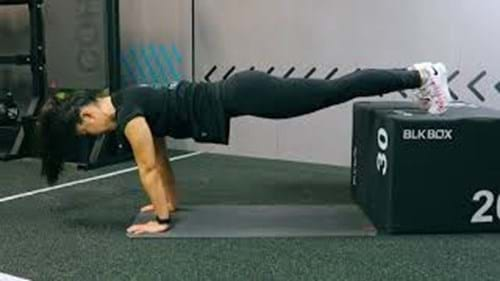Decline Push Ups
What Is A Decline Push Up?

Decline press ups (also referred to as decline push ups, feet elevated push ups or downhill push ups) are a variation of the classic push up exercise, that involves raising the feet off the ground, creating a downward slope with your body.
Unlike regular press ups, which evenly distribute effort across the chest, decline press ups place more emphasis on the upper pectoral muscles and is a great way to work the serratus anterior muscles, which are responsible for stabilising the shoulder blades.
The increased resistance of pushing your body 'uphill' as well as the emphasis on the lower chest mean most people find decline push ups more challenging than regular push ups, and it's a great progression if you find standard push ups easy. You can increase the difficulty of decline push ups by increasing the distance the feet are raised off the ground.
Check out some other press up variations: medicine ball press ups, diamond press ups, spiderman push ups, pike push ups, one arm push ups
Commonly Asked Questions On Decline Push Ups
Decline press ups primarily target the chest muscles, with an emphasis on the lower portion. While the shoulders are involved for stability, the focus is on the chest. You can find shoulder exercises here to include in your training routine.
- Upper pectoralis major (chest): The decline angle places a greater load on the upper portion of the pectoralis major, leading to increased activation and development.
- Triceps brachii (triceps): The triceps muscles, located at the back of the upper arms, play a significant role in extending the elbows during the upward phase of the decline press up.
- Anterior deltoids (shoulders): Both the anterior (front) heads of the deltoid muscles are engaged during decline press ups, contributing to shoulder development.
- Serratus anterior: This muscle, located on the sides of the chest, is activated as it helps stabilise the shoulder blades during the decline movement.
- Rectus abdominis and obliques (core muscles): To maintain a straight body position, the muscles of the core, including the rectus abdominis and obliques, are engaged throughout the exercise.
While these muscles are the primary focus, decline press ups also involve various stabilising muscles in the back, hips, and legs to support the body during the movement.
The height of your feet during decline press ups depends on your fitness level and the available equipment. Start with a low surface, such as a 3 inch plyo box. As you gain strength you can increase the height to make this exercise more difficult. If you are unable to complete the reps with good form, lower the step.
The ideal angle for a decline press up typically ranges between 15 to 30 degrees. Your body should form a straight line from head to heels, and the downward slope created by elevating your feet enhances the engagement of the lower chest muscles. Adjust the bench or surface to achieve the desired angle, ensuring a challenging yet controlled movement.
Decline Push Up Tips
- Maintain proper form throughout the movement by keeping your body straight from head to heels and engaging your core muscles for stability.
- Adjust the height of the surface your feet are on based on your fitness level. A higher surface increases the difficulty.
- Perform the push up in a slow and controlled manner, both during the descent and ascent phases. This ensures muscle engagement and reduces the risk of injury.
- Allow your elbows to flare out at a 45-degree angle from your body to target the chest and reduce stress on the shoulders.
How To Do Decline Push Ups
Start in a plank position with feet elevated on a plyo box, bench, stability ball or chair.
Place each hand as wide as is comfortable. The wider apart your hands are the harder you will work out your chest.
Slowly lower your chest towards the floor whilst keeping your abs braced and back straight. Your arms should stay close to your sides during the movement.
Pause before slowly pushing yourself back up to the start position.
If you’re not sure if any of the above exercises are suitable for you, please consult your doctor before you start it. Need guidance on how to perform the exercise? Ask a personal trainer at your gym.